Top dressing of tomatoes with calcium nitrate

Any plant needs not only sun and regular watering, but also vitamins. Trace elements are indispensable in the process of photosynthesis and pollination of plants. This is true for tomatoes as well. Gardeners often feed the plantings with useful fertilizers, due to which the plants bear fruit well. Saltpeter is often used, but this tool must be used according to certain rules in order to ensure an excellent tomato harvest.
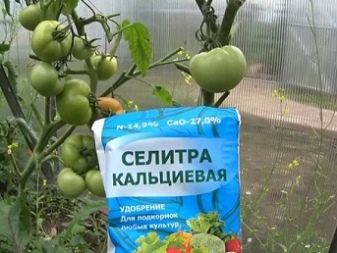
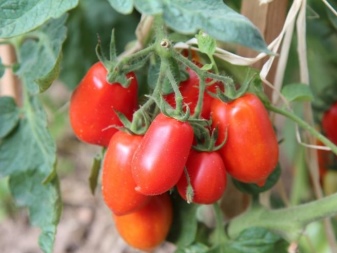
Peculiarities
Saltpeter as a fertilizer has a number of features: wide production, as well as availability for ordinary gardeners. In the agricultural sector, saltpeter is considered one of the best fertilizers. Calcium nitrate, also known as calcium nitrate, is a mineral and a widespread fertilizer. The substance can be purchased in the form of granules or a scattering of small crystals. The product dissolves quickly in water. Saltpeter can be of several types:
- potassium based;
- ammonium nitrate or barium;
- based on calcium and sodium.
Potassium-based saltpeter is not used in gardening... When using fertilizer, it is important to follow the instructions: observe the exact dosage and adhere to the time when the fertilizer "works" most effectively. Thanks to this, an excess of funds will not be created in the soil and the crop will not die. At home, potassium and ammonia-based nitrate is often used. Fertilizers have a good effect on abundant fruiting and plant growth. Not all farmers understand how important calcium fertilization is for plants. Thanks to this vitamin, tomatoes grow very quickly, since calcium helps plants to quickly absorb nutrients from the soil. Without calcium, even the most effective fertilizer will not work - the plant simply will not be able to absorb nutrients and will not assimilate them.
Calcium nitrate consists of 13% from nitrogenous substance and 19% from calcium... This agent is used to fertilize vegetables from the moment of germination of sprouts to the very harvest. Top dressing does not smell. If stored incorrectly, it quickly cakes. If there is too much humidity in the air, the saltpeter will absorb the excess moisture.
The product does not create an acidic environment in the soil. Saltpeter is perfect for feeding on any kind of soil.
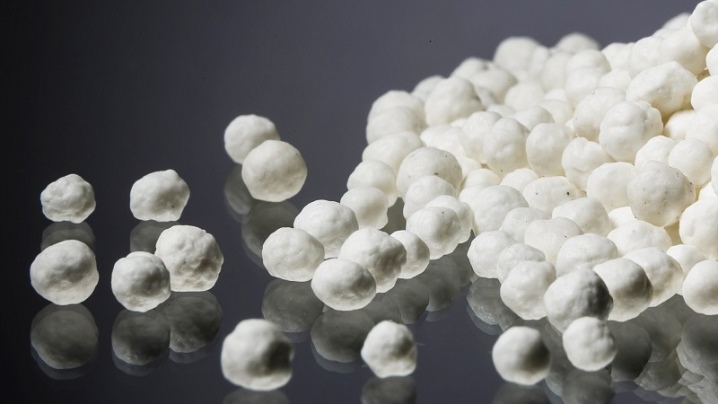
Advantages and disadvantages
Please note that the type of fertilizer is essentially nitrate. It can accumulate in the body of plants and negatively affect the human body.
Benefits of Calcium Nitrate:
- the substance strengthens the roots of plants, and also helps them grow better;
- increases the natural defense of plant crops against various diseases;
- helps plants to better tolerate extreme heat and cold, while increasing their resistance to sudden changes in weather;
- saltpeter improves plant development at the cellular level.
In addition, saltpeter of this type:
- takes part in the metabolism of the plant, promotes the production of enzymes, stimulates the growth of crops;
- provides fast photosynthesis, thanks to the product, carbohydrates are delivered and the plant assimilates nitrogen well;
- the yield increases by about 15%, crops are better stored in cold weather, the fruits look beautiful and acquire a bright taste.
One of the disadvantages of the tool can be called the negative effect of the drug on young roots or leaves of freshly sprouted tomato sprouts. This is due to improper feeding with saltpeter. A good harvest of tomatoes will be possible only if all feeding is done strictly according to the instructions.
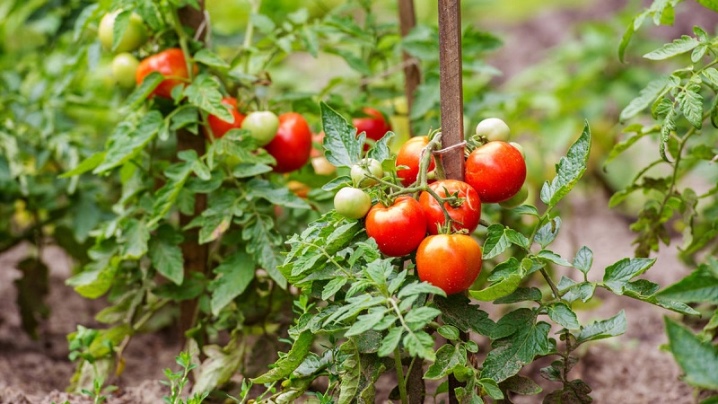
When and how to feed properly?
According to the rules, it is best to start using saltpeter in the spring. The best stage is the seasonal digging of the soil.... Fertilizer should be applied just before sowing the plants, when young sprouts need nitrogen so much. However, nitrogen will be properly assimilated if the soil contains a large amount of calcium. When fertilizing tomatoes, calcium-based nitrate will be useful at the start of the growing season. During this period, it will become an effective preparation of the soil around the roots. In the fall, you should not carry out top dressing with this tool - when the snow melts, nitrogen is washed out of the ground and the plants cannot absorb calcium.
It is imperative to pre-spray the tomato bushes before they bloom. The most important thing is to properly dilute the fertilizer in water, observing all proportions. The ideal time for processing tomato plantations is 7th day after planting plants in open ground. If the soil on the site has increased acidity, then you can pour nitrate granules into the pits intended for planting tomatoes. For one culture, one teaspoon of the product will be enough.
In order not to harm the tomatoes, proper watering of the seedlings is necessary.... At each stage of the development of tomato bushes, you need to change the method of fertilization. Calcium is often the best food for private gardens. In special stores, you can buy fertilizer in a mass of 2 or 1 kg. The instruction states that it is impossible to combine fertilization with this agent at the same time with mineral agents containing phosphorus or sulfur. This type of nitrate can be called a universal top dressing for all types of plants. The product must be diluted in clean water. To enter nitrate, drip irrigation is used. Drop by drop, the composition penetrates directly into the roots of plants.
It is a versatile product for both hydroponic cultivation and greenhouse plants.

Seedling
In order for the seedlings to grow strong, you can feed the sprouts with a composition of nitrogen and calcium. Calcium will help seedlings grow faster, and nitrogen is great for root development. It is not necessary to combine calcium with nitrogen and superphosphate in the fertilizer at the same time, as well as with compositions based on sulfur or phosphorus. Each gardener wants to get the largest possible harvest from his site. Reaping a truly rich harvest requires just a little effort.
For plant health, it is necessary to feed crops with saltpeter, which has a great effect on the growth of vegetables, develops their root system and helps fight parasites and diseases. It is important to follow the instructions for feeding the product correctly. Although saltpeter is not toxic, if used improperly, it can only harm the crop and the person himself. If you add saltpeter to the roots of plants, when ovaries are already forming, vegetables will begin to accumulate nitrates. Pouring too much saltpeter into the dressing can cause burns on the leaves of tomato bushes.
Complex nutrition for young tomato seedlings will provide an aqueous solution. Calcium fertilizer is great for tomato bushes. If the first 3 leaves appear on the sprouts, then you can add fertilizer to the soil. To create fertilizer you need:
- take 5 liters of water;
- mix about 50 grams of ash and 5 grams of urea with a liquid;
- add saltpeter there (about 10 grams).
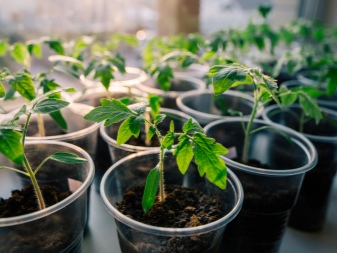
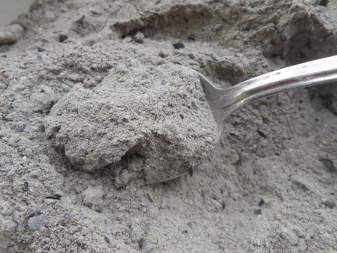
The solution can be poured in little by little under the roots of the plants. You need to try not to get on the leaves so that burns do not appear on them. At this stage, saltpeter cannot simply be poured under the roots. It is necessary to carefully spray the soil under the plant. If the plants are grown in a greenhouse, then they should be constantly fed with nitrogen fertilizers. This must be done before the flowering of tomato bushes.
If you use a fertilizer with 1% nitrate, you can save plants from:
- slugs;
- top rot;
- thrips;
- ticks.
The solution is prepared from 10 liters of liquid, in which you need to dissolve about 100 grams of nitrate. The composition has an excellent effect on the immunity of tomatoes, retaining its properties even after the termination of feeding. A conventional spray bottle is suitable for spraying the composition.
Foliar fertilization should be started only 10 days after planting tomatoes in greenhouses. Feedings should be repeated every 14 days during half of the tomato growing season.

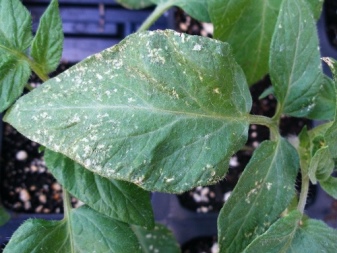
Mature plants
Saltpeter is essential for the formation of a healthy inflorescence ovary. To make a mixture, you need to take a bucket of water and stir 500 grams of bird droppings in it. Add about 20 grams of calcium nitrate to the mixture. Can be mixed into solution and nitrophosphate.
Saltpeter should be added to plants only during flowering and ovary formation. Thanks to such feeding, the soil becomes better, oxygen reaches the roots faster. The nitrogen in the fertilizer helps crops grow faster. If a plant is deficient in nitrogen, then this can be understood by the following signs:
- thinning of leaves;
- small size of bushes and bad ovary;
- shedding of the kidneys;
- redness of the plant.
You can solve the problem of nitrogen starvation with the help of special feeding... Approximately 10 grams of nitrogen calcium should be added to the solution per 10 liters. For each plant, the consumption of the composition will be 500 ml. If you combine watering and feeding, nutrients will reach the plant roots even faster. If the bushes are supplied with nitrogen in time, beautiful and tasty fruits will grow on them.
If amine feeding is planned, then the type of feeding cannot be changed during the entire growing season of the plant. You need to choose one complex of minerals and use this dressing together with organic compounds in the same way. Tomato bushes grow well when fed, even during fruiting. However, they grow even better if not fed.... The crop can grow too quickly, so the fruits on it will begin to dry out and crack. Only if all the rules for growing vegetables are observed will tomato bushes give an excellent harvest.
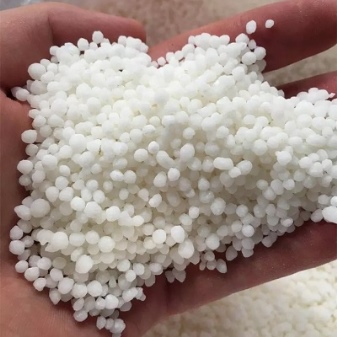
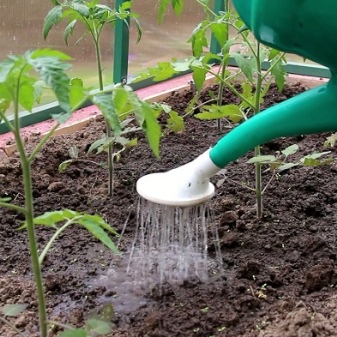
Combination with other fertilizers
Do not mix calcium nitrate with:
- chalk and phosphates;
- lime;
- dolomite and sawdust;
- straw and manure.
Combinations like these can simply burn the plant. Top dressing in the form of nitrate can only be combined with urea and ash - these are folk remedies. The substances work well in tandem and improve the growth of tomatoes.
Potassium nitrate must be used separately. This tool is necessary for the timely mineralization of the soil.

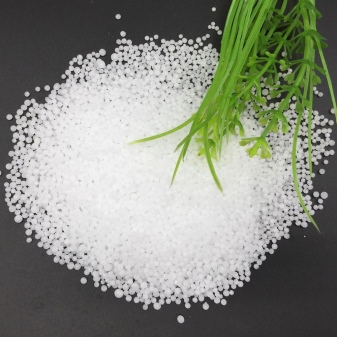
Precautionary measures
The introduction of calcium when growing tomatoes is considered non-toxic and completely safe for humans. Top dressing does not cause allergies. By qualification, the agent is ranked among the 4th group of solutions, characterized by low danger to nature and humans. In this case, it is better to follow all safety measures. Rubber gloves are enough to protect your hands. Although you can work without gloves, and the product will not cause any harm, it is still better to dilute the solution in protection.
A sealed vessel is needed to store saltpeter. The substance should be stored away from:
- heaters and stoves;
- flammable materials;
- alkalis.

Helpful hints
Calcium nitrate will only be beneficial if used correctly. Not all recommendations can be seen in the instructions. Even experienced gardeners will find advice on the correct use of nitrate.
- Calcium nitrate absorbs liquid very quickly... It is better to immediately use the packaging with nitrate crystals. If you need to feed a small area, then it is better to choose a substance in granules.
- On soil that is rich in alkali saltpeter is used with caution.
- The feeding rate cannot be exceeded - a large dose can lead to the accumulation of nitrates.
- Due to too high dosage of fertilizer fattening of tomatoes may occur.
- The tool can be used only in spring or summer. In autumn, during the rainy season, nitrogen is simply washed out.
- Spraying can be carried out on the leaves.
- At the very beginning of plant growth, nitrogen in calcium may be low, therefore, you can feed the plants with other means with saltpeter.
- The tool is needed dissolve in water.
- Potassium can block calcium in fertilizerstherefore a 0.7: 1 ratio of these minerals is suitable for good digestibility.
In order not to spray or water the tomatoes many times, it is better to use tanks with different mixtures. With their help, plants can be processed several times faster. Calcium-based nitrate foliar application is simply necessary if tomatoes grow in conditions of temperature extremes.
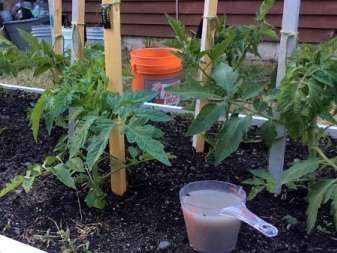

In the next video, you will find fertilizing tomatoes with calcium nitrate.













Very useful information.
The comment was sent successfully.